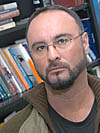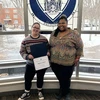Musings during a recent trip through China are the inspirations for Mohawk poet James Thomas Stevens’ sixth book of poetry, A Bridge Dead in the Water, which plumbs the depths of experiences of Native peoples on two continents.
Said to have once been an exposed strip of land that brought Asian settlers to the continent of North America, the Bering Strait Land Bridge has also become a metaphor for the conflict between Europeans and Native Americans. Just as science and religion clash in all cultures, the Bering Strait theory has appeared to trivialize the hundreds of creation accounts that were fundamental to the traditions of Native peoples in North America. Read why the theory antagonizes many Native Americans.
|
|
Professor Stevens, who teaches English at SUNY Fredonia, researched the effects of colonization on either side of the strait – China and North America, in preparing to write his newest collection.
His explorations took him to unexpected sources that gave a glimpse into the lives of native peoples. For example, the Mutual Life Insurance Company of New York’s 1901 published list of accidents, emergencies, and illnesses became the inspiration for a key poem in the book, “The Mutual Life.” Two other poems focus on mapping, authority and propaganda, while the short poems recall some of his more personal experiences. is on the brink of release by Salt Publishing of Cambridge, U.K., which is issuing Professor Stevens’ new volume as part of the Earthworks series, an award-winning collection of Native American writing. The book comes on the heels of Professor Stevens' summer release and fifth book of poetry, Bulle/Chimere (First Intensity Press).
A descendant of indigenous Americans, Professor Stevens is by birth an Akwesasne Mohawk, belonging to a tribe of peoples from a territory that extends from Northern New York State into Ontario and Quebec. Born in Niagara Falls, however, he grew up on the Tuscarora Indian Reservation in the Town of Lewiston, within the Iroquois Confederacy.
Emerging at a young age as a gifted writer, he was admitted with a full fellowship to the Brown University Graduate Writing Program after finishing a two year Fine Arts degree in creative writing at the American Institute for Indian Arts. He was only the second student in the history of Brown to be admitted to the M.F.A. program directly from a two-year program. By then he had won awards, studied under some of the premier writers of America, and read his works publicly.
Despite fulltime teaching, the awards have continued, as has Professor Stevens’ teeming creativity. In 2000, he won the $35,000 Whiting Writers Prize as an emerging talent, and in 2005 was a National Poetry Series Award finalist.
Frequently invited to other campuses to give readings, in December he will discuss the American ethnopoetics master, Jerome Rothenberg, on a panel at the Modern Language Association. This week, he is delivering a paper on race, ethnicity and religion in Istanbul, Turkey, at Bogacizi University and the annual conference of the National Association for Ethnic Studies.




